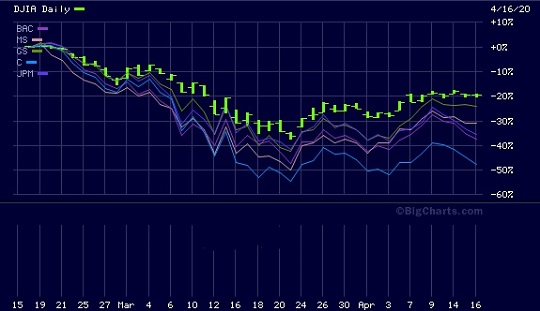Americans Are Paying a Tragic Price for Allowing Five Banks to Control the U.S. Economy
Published: April 18, 2020
Source:
Wall Street On Parade
Bank Stocks’ Trading Pattern February 14 through April 16, 2020 versus Dow Jones Industrial Average. (BAC = Bank of America; MS = Morgan Stanley; GS = Goldman Sachs; C = Citigroup; JPM = JPMorgan Chase.)
According to the Federal Deposit Insurance Corporation, as of yesterday there were 5,117 federally-insured banks and savings associations in the United States. But in terms of risk to the U.S. economy and financial system, according to the U.S. Treasury’s Office of Financial Research, only five of those banks matter. And as you can see from the chart above, those five banks are tanking.
On February 14 of this year, Citigroup’s share price closed at $78.79. Yesterday, it closed at $40.52, a decline of 48.5 percent in two months. This is the same bank that was resuscitated by its regulators during the 2007-2010 financial crash when its share price went to 99 cents. Citigroup received the largest bailout in global banking history, including $2.5 trillion in
secret, cuмulative revolving loans from the Federal Reserve.
On February 14, the common stock of JPMorgan Chase – the bank that has perpetually bragged for years about its “fortress balance sheet” — closed at 137.46. Yesterday JPMorgan Chase closed at $87.33, a decline of 36 percent in two months.
As the chart above indicates, the stock prices of the Wall Street mega banks are performing far worse than the broader market as measured by the Dow Jones Industrial Average (green line). That’s very bad news for the U.S. economy because it’s the industrial and energy and pharmaceutical and technology companies in the Dow that need to borrow from these banks in order to continue paying salaries to millions of workers and avoid severe layoffs. The financial condition of these banks essentially means the difference between the life and death of the U.S. economy. It’s not looking good so far.
Federal Reserve Chairman Jerome Powell joined the Federal Reserve’s Board as a member on May 25, 2012. Over that time Powell should certainly have become aware of the repeated warnings of the Office of Financial Research (OFR) that America was at dangerous risk from ignoring the concentration and leverage of its banking sector. But instead of reining in these concentrated risks, the Federal Reserve has allowed them to mushroom.
In
a February 2015 report the OFR wrote this:
“The larger the bank, the greater the potential spillover if it defaults; the higher its leverage, the more prone it is to default under stress; and the greater its connectivity index, the greater is the share of the default that cascades onto the banking system. The product of these three factors provides an overall measure of the contagion risk that the bank poses for the financial system. Five of the U.S. banks had particularly high contagion index values — Citigroup, JPMorgan, Morgan Stanley, Bank of America, and Goldman Sachs.”
According to the Office of the Comptroller of the Currency (OCC), the bank holding companies of those same five banks as of December 31, 2019 were sitting on astronomical levels of highly combustible derivatives: in notional (face amount) of derivatives, JPMorgan Chase held $46.4 trillion; Citigroup held $40.8 trillion; Goldman Sachs Group had $39.6 trillion; Morgan Stanley sat on $32.5 trillion while Bank of America held $30.4 trillion. These five banks represented
83 percent of all derivatives held by the more than 5,000 Federally-insured banks in the U.S.
Read More...Share This Article...